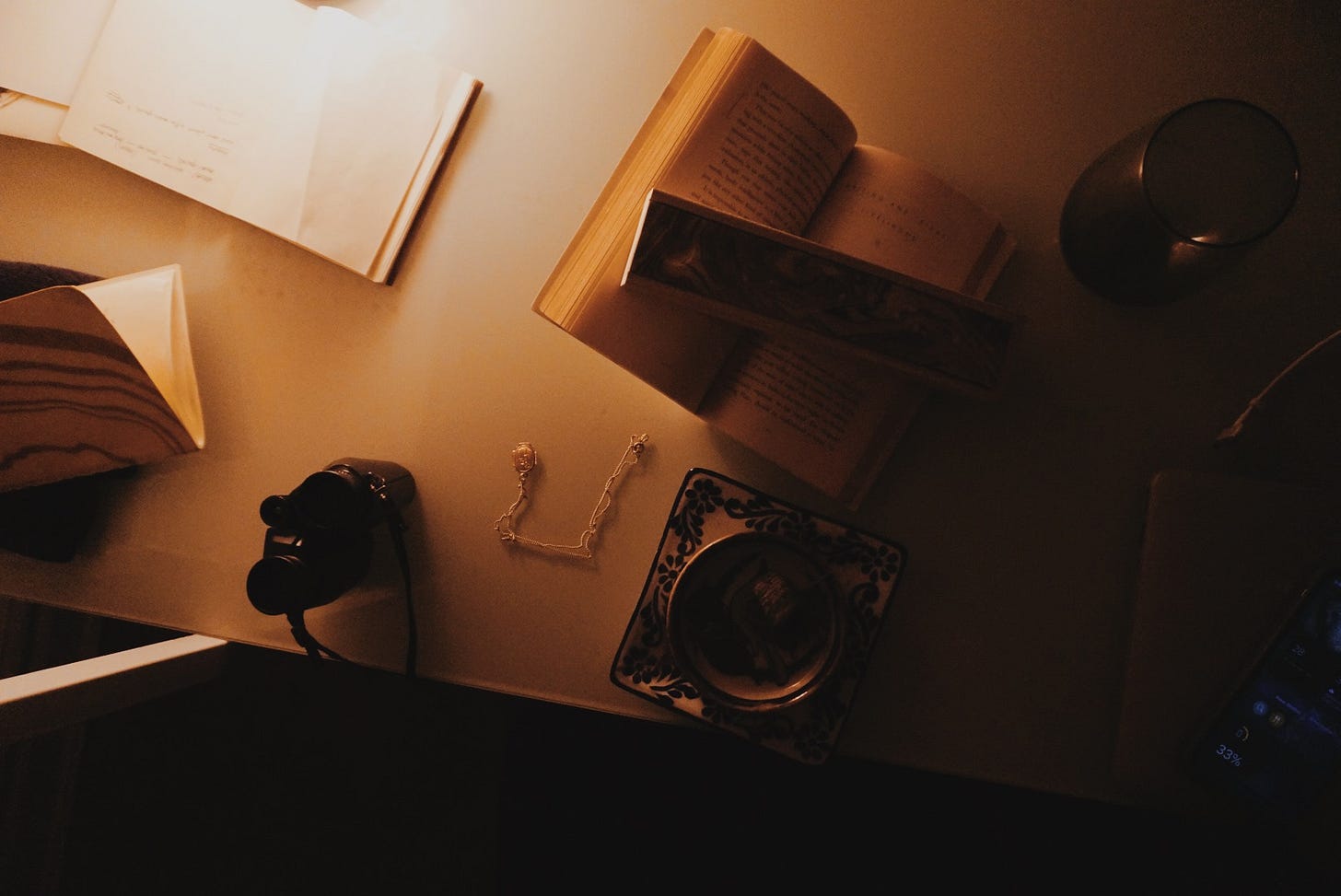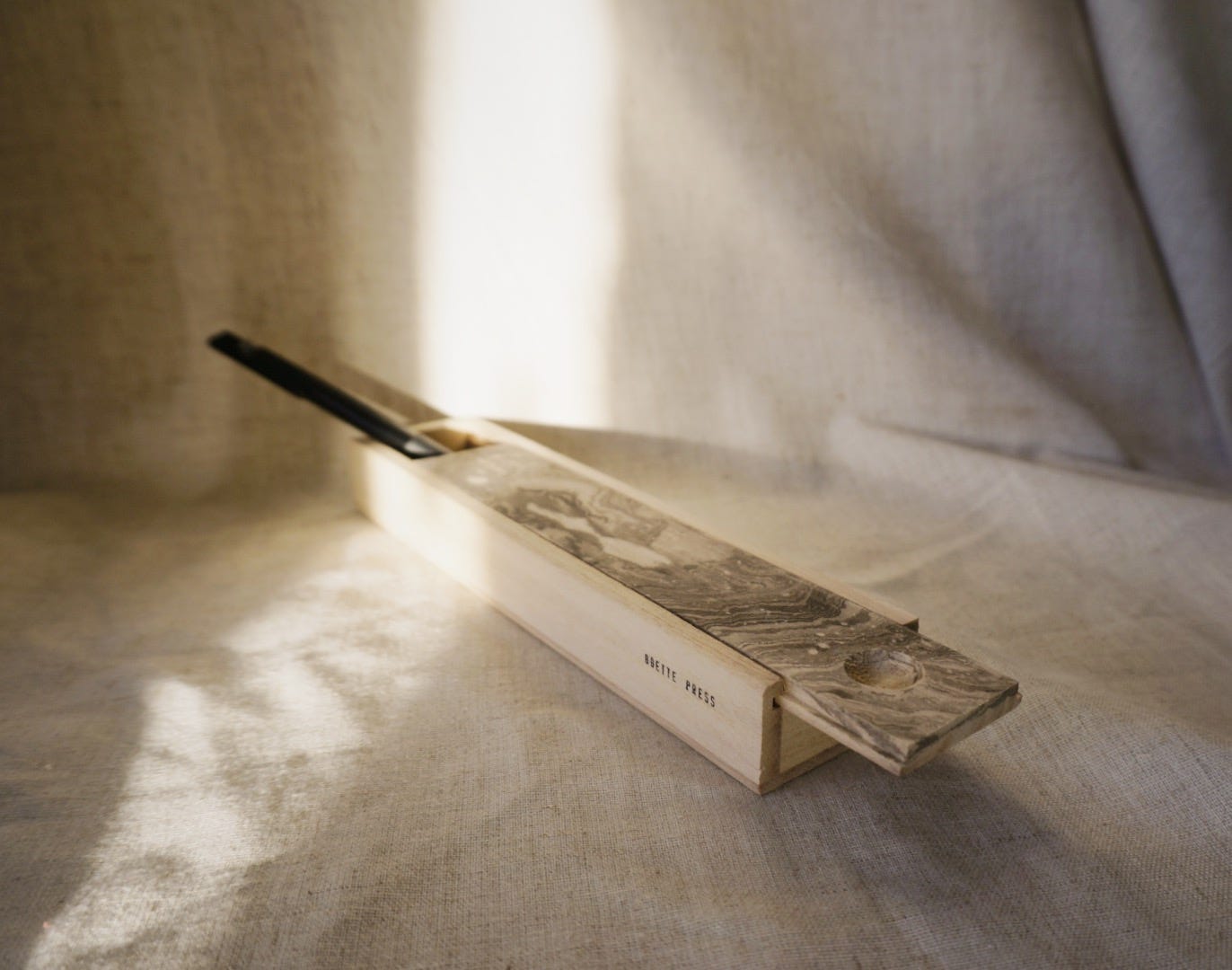To any readers in NYC, February experiences have arrived, and you’re invited — sign up here. Ground down into creativity: learn meditation, journaling, paper marbling, and bookbinding. If you’re curious about starting, strengthening, or sustaining a creative, writing, or meditation practice, my 1:1 sessions may be a good fit. Read to the bottom to see a new addition to the shop, and as always, shop journals at Odette Press.
Dressed in electric lime and bright yellow green is the man standing yelling into his phone. We are both in the cold on the sidewalk, and it is early morning, and too early, and too cold, I think, for this much anger — that is, until I arrive closer, and hear the specificity and texture of what it is he’s trying to say.
This eruption foregrounded on the sidewalk, he stands, shouting. He is upset, and I understand. “To hell with it,” he says. His voice is loud, harsh, all edge and angle and biting, vocal tones resounding off of metal plates, off of piles of two by four pine, embodying this anger, his back to the the city in the distance, shouting at a creditor on the other line. He is angry, of course he is, stuck in the anguish of suffering.
For a breath I brace myself for passing by this temporary volatility, taking in this emotional impact. He stands, shaking visibly, all energy in motion while I shake from the first sips of cold, and my muscles unfolding, and I want to yell at times, too, though I prefer to pour into language that is precise and connecting, words to vocalize and to create ground by which to ground down, and find commonality. Running past, I imagine ways to use words as a vehicle the ground of activity, whereby we share conversations and move into a world and ways of being where conversations like these, of anger over the preference of profit over people, don’t punctuate the quiet of morning. For now, anger. He screams into the void; I sing and yell into my car, and shake into the cold as I run.
Trailing off into the distance past him, I notice how hot anger arises and leaves, becoming breeze, as his voice becomes a tendril. Waning, lessening, the heat of anger becomes smaller the further I go. I feel for him, holding for a minute this temporary hot ember until the reverberations of voice disappears into distance, welled into atmosphere, down into the tunnel of his phone. I feel the ground, sharply exhaling, and discard the feeling, and leave it at my feet. My feet on the Earth, I find pacing. I move forward. I keep running.
My intention that morning is to avoid the burst of a sprint, rather to gather energy and sustain it. Do not burn out, I think. Pacing myself, I return to thinking. I am inside the cocoon of my mind, all idea and feeling sensing, morning body moving forward in a line of motion. On the air I smell pine from this construction, along with growing piles nearby where December’s trees, once gathered around, wound, and adorned with bright lights, are now shredded, confetti, discarded.
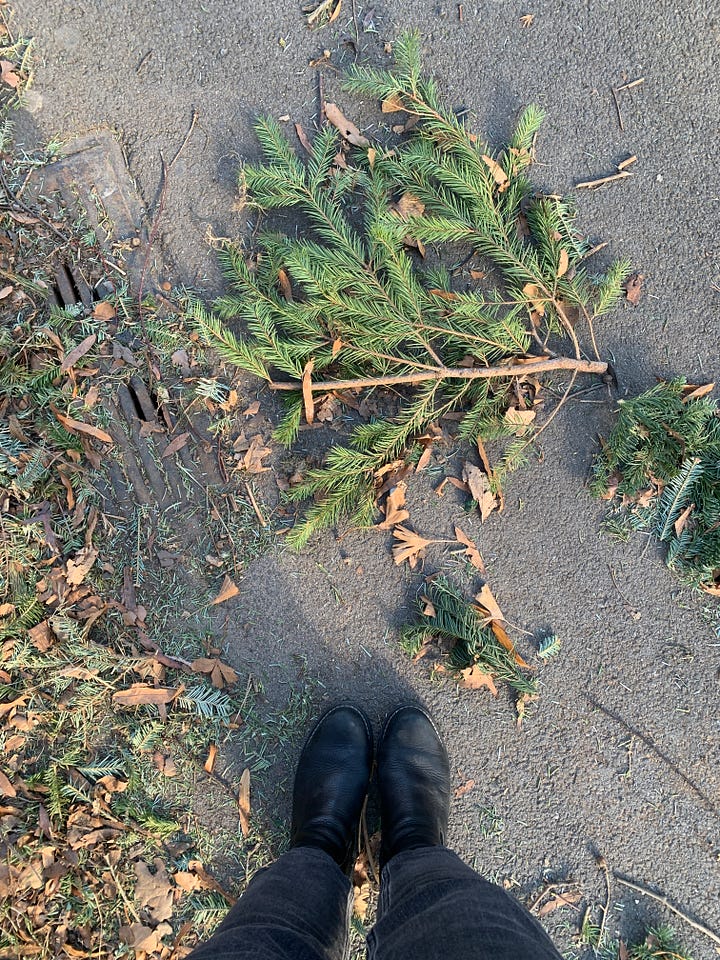

Metal tools, wires and earth, two by fours line the cracked sidewalk by this shoreline; the view is feet and feet of a bright highlighter orange, this temporary plastic, a boundary, a fence, a permeable enclosing, and if I soften the gaze of my focus I can play with vision and pretend it’s a Christo and Jeanne-Claude, an intervention of fabric, and not a construction site. Body and thought in motion, I start to trail off, wondering why we value what we do, what we choose to make and deem as beautiful, in the conversation between beauty and art, and labor and utility, contemplating the distinction between finding something beautiful between what we see on the ground or on gallery walls, asking the moment: what matters here?
The day is frozen solid and they are cutting up the cement path. Jagged holes in the sidewalk. Loud and fast and working long and cold hours over long periods. Giant metal machinery. These men on the job, men in the Earth, men in these holes inside the ground, immersed between the honey and red rust of the soil that surrounds them. Tool, metal, Earth removed and replaced. Tasked with tending the land and rerouting pipes, they take hand tool, map, plan, conversation, and metallic force, constructing pathways and erecting fences, to ensure the park opposite the shoreline.
To hold these spaces open, each chasm is protected overnight, covered over and encased with temporary metal plating. Material, matter, moment — each morning I run and meditate on the changing nature of these steel plates. Metal takes on the qualities of mineral, changed by acid, heat, sunlight, water, friction of salt, and covered in thinning layers of paint, I watch as these fields of color shift and morph with the changing seasons. These steel grounds are harsh line, angular, rectangular, metallic, and unyielding, covered in fading reds and sun-worn yellows and greens, paints that were once bright and vibrant and orange-red, bleached by time. I close my eyes for a minute, blurring vision, pretending these squares of steel are meant to be color field, painting, ground down by salt and the soft beat of repetition, of feet like mine, passing by and running.
In contrast to the soft soil and the power and rhythm of water on the shoreline, and the snow as it piles up and in the sunlight, these metal plates show the boundary of four lines and I feel the unfamiliar ground, looking for spaces where this temporary metal mixes with water, making the ground slick. Running requires a trust in the strength of your body and the ground, and like writing, like placing language, trust is built slowly, in increments — in the repetition of placing and replacing each step on the ground. But this false earth becomes my landing place as I run in an already cold and slick season, and everything I’ve come to know about steadiness, and feeling grounded and sure in my feet, comes into question; to run on metal is a textural abnormality absent the friction of sidewalk and soil.
Tuning in, I feel into wherever I can that I’m steady: the four corners of feet, the strength of each toe, as I run past the four sides and four corners of these strange, metallic plates. Often when I am running I bring an essay with me. I find that an idea starts to form in the seemingly empty space between movement and stillness, in the dialogue between mind, body, and life. Ideas well up, precipitate, and emerge, and like breath or heartbeat, need that dialogue been activity and rest.
Traveling back and forth between the landscape of inner life and being immersed in the world, I notice. Idea starts like a spark in the heart or mind, a drop of water, a ground covered spring, the small dot of starlight or ember. I hold it with me, choosing whether to stay with it, let it rest, or put it down. I sip the idea, hold it in my arms, cup it in my palms, let my stomach digest it, then give it to my legs to ground down, playing with pacing. I notice what stays and what goes, asking the idea, what is it that matters here?
An idea forms and I feel the vitality of synapses connecting; I watch as expression becomes ground below and cloud overhead, shifting and emerging. Writing down the first pass, I open up so the ideas can be jumbled, half thought and potent, rich like soil, burgeoning with energy, full of feeling. Let the first draft and pass arrive however it is; let it be and embody beginner, awkward and half formed and new, and then become solid: hold the idea and walk with it. Then shake off the excess: hold it and run with it.
In Writing Down the Bones, Natalie Goldberg observes:
“Often I can look around the room at my students as they write and can tell which ones are really on and present at a given time in their writing. They are more intensely involved and their bodies are hanging loose. Again, it is like running. There's little resistance when the run is good. All of you is moving; there's no you separate from the runner. In writing, when you are truly on, there's no writer, no paper, no pen, no thoughts. Only writing does writing—everything else is gone.1”
Across the landscape of time, ground has meant “bottom, foundation, surface of the earth” and also “soil” “a deep place” “a shallow place”. Growing in meaning, ground came to include both “reason” or “motive,” and “a connection to the earth” as it connects to electricity. Standing into the word, ground also carries with it the roots of care or a currency drive, heart, or determination: the place by which we find ourselves grounded from, or rooted into, gives a steadiness and steadfastness to standing up for something, or finding firmness in.
To give ground is to sense what you stand into, to root from this place, and keep going, and as heat builds in the container of my body, I find stamina, ground, and continue running. To ground in creativity is to at once be so firmly rooted, to trust the ground you’re on, so much so that you can let go into the moment; the quality of lightness unfolds once the place of steadiness once the heaviness shakes off. On the practices of running, writing, and grounding into body, Gail Sher writes, “That may be why writers so often prepare for writing with a wordless, rhythmical, monotonous activity that grounds them in their bodies, absorbing outer attention while freeing inner.”
I watch as these large machines sit silent on the weekends; how metal plates serious in stillness enclose these chasms of ground, noticing the way I can still step, run, ground, and burst forth. On the coldest day so far, snow comes, encasing the day in specks of freezing, as if running into a screensaver or atmosphere of stars, as if each contrast of cold speck and hot cheek were a new universe forming, as body, mind, breath, and legs keep moving. I feel snowfall as specks of contrast, and feel grateful to be in motion.
The details of the moment, this attentiveness is what brings ground to noticing and writing. In writing, we ground into details: we bring vividness and aliveness not only in the act of what is present, but what we are feeling, sensing, and witnessing. “Writing ‘down,’” Sher continues, “means to plunge into the depth of a detail, extract its essence and allow this to permeate and vitalize the piece as a whole.” It is from the details the bones and ground of our writings form. She says “Writing ‘down’ makes the minutia of an imaginary world spring to life.”
Like running and breathing and being in life, when writing, I can feel and sense when I am in it. I am in the groove, in the pocket, riding as gull on wind, like the men immersed in those tunnels of morning. Ideas coalesce and precipitate; they rise and drip from agitation and presence equally, coming to form in stillness and in dream states. Trailing from both effort and ease, the flow of ideas come to form in challenge, in motion, in single-pointed focus in challenge and solution solo and in tandem, and approaching a bliss state.
On grounding into idea and motivation, in the dance of expression, Martha Graham writes,
“There is a vitality, a life force, a quickening that is translated through you into action, and there is only one of you in all time, this expression is unique, and if you block it, it will never exist through any other medium; and be lost. The world will not have it. It is not your business to determine how good it is, not how it compares with other expression. It is your business to keep it yours clearly and directly, to keep the channel open. You do not even have to believe in yourself or your work. You have to keep open and aware directly to the urges that motivate you. Keep the channel open.”
The effort of any practice asks for both the steadiness of ground, and the flexibility to flow, to go forward, and continue. To stand is to be grounded, to be solid, flexible like green branch growing — some flexibility so as not to break, but still living with firmness. Practice implies process, and some pliability, and will change, based on the ground you give yourself, the time, your focus, your season, and what you can contain. Practice is forgiving, amassing stamina and sustenance in small increments, as growing wood is flexible enough to slope but stop before it snaps entirely. Practice implies an ongoingness and creates continuity.
What occurs to me in each season on each run is the need for repetition and rest and forwardness in the act of sustaining. Which is to say you find something small to ground into, to drive you forward, some way to keep going. How often anything — breath, word, skillful thought, kernel of joy, challenge unraveled, practice of movement or writing — starts from a single point. A dot becomes a line becomes a shape half formed becomes a rectangle, and the art of your thinking and being is contained and continued and transformed into something.
I think about ground of practice, on creativity and right environment, about the intricacies of accumulation: a single snowflake alone will not become slick ground for sleds, or snow piles, blocked roads, but trillions rained down on a cold enough day will coalesce given the cold enough environment. Snowflakes become storms, and starlings murmur and become large morphing fly bodies of synchrony and shape, while pennies become dollars, and dollars become thousands. A single word, or breath, or mile run may feel, for a time insignificant, but in their accumulation over time, they coalesce, strengthening.
As I write this, it occurs to me that to be grounded implies at once the spaciousness to be still and the possibility to be uplifted. That it’s from an inner ground we can feel safe and strong enough to open wide, and create, expand, and open up. The more grounded one becomes (which is to say steady, present, trusting, and surefooted) the more you come to trust the pace and the ways in which you place your words, ideas, and feet, and hold capacity for the insistence of life in all its states. Giving ground to anger, to wonder, to boredom, to bliss provides the ground for multidimensionality of emotion. It’s human.
From the root of your smallest toe all the way up to the sky, presence is a sidewalk, a trail, a highway. You drive your attention up and down, tracing along the edges of your capacity, writing your mind along the highways of the whole of your sensing: mind, body, heart, emotion.
Held by idea, gravity, and the ground of movement, I feel the ecstasy of pace, breath, and endorphin and I feel the ways in which I am alive, resoundingly, yes, noticing the ground, the colors, the intricacy of snowfall, of shape. The four corners of my feet run again against this unsure ground, and when I pay attention to it, I notice exquisite gift of momentum and balance while running.
To stand firm with your feet in the present tense and feel the strength of your footing and your legs gives you the ground of your practice. It shows the ways you are landscape, skyline, water, about everything you can contain or digest, and the incredible capacity of heart in the cavern of your chest. Creativity speaks in a constant whisper, a rhythm, sometimes yelling, sometimes pounding, sometimes stitching the thread: Write me. Write me. Write me.
How does the vibrancy of your writing, your creativity, your life change if you are steady, present, trusting, and fully engaged? Try this: play. Find a still point and feel the firmness and solidity of your experience. Feel your feet on the ground, your body in space, or press down into your palm, and feel the four corners there2. Root down into the stable bast of of your feet, locate the ways you already embody or contain a place that is very stable. Play again. Take a piece of paper. Fold it into four corners, and in those quadrants, write a map back to the ground of your practice. Make a list of what the wind tells you, and the heat, and the landscape, and the water. Use it like map, a map back to the core of you, at your center. Notice what drives you, guides you, urges you onward. Give yourself ground. Plant words like seeds. Continue.
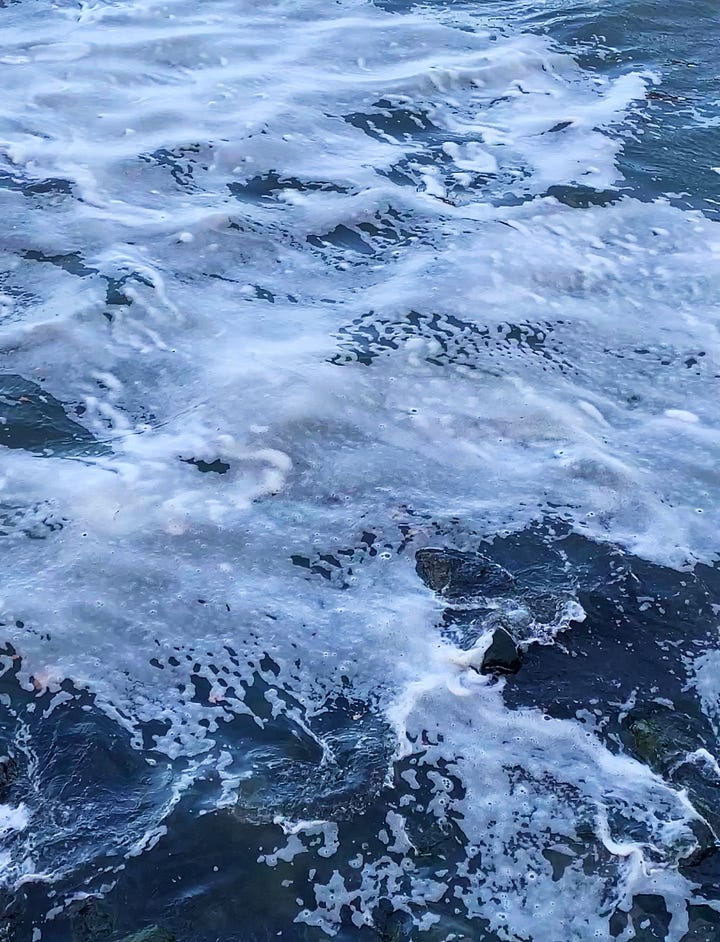
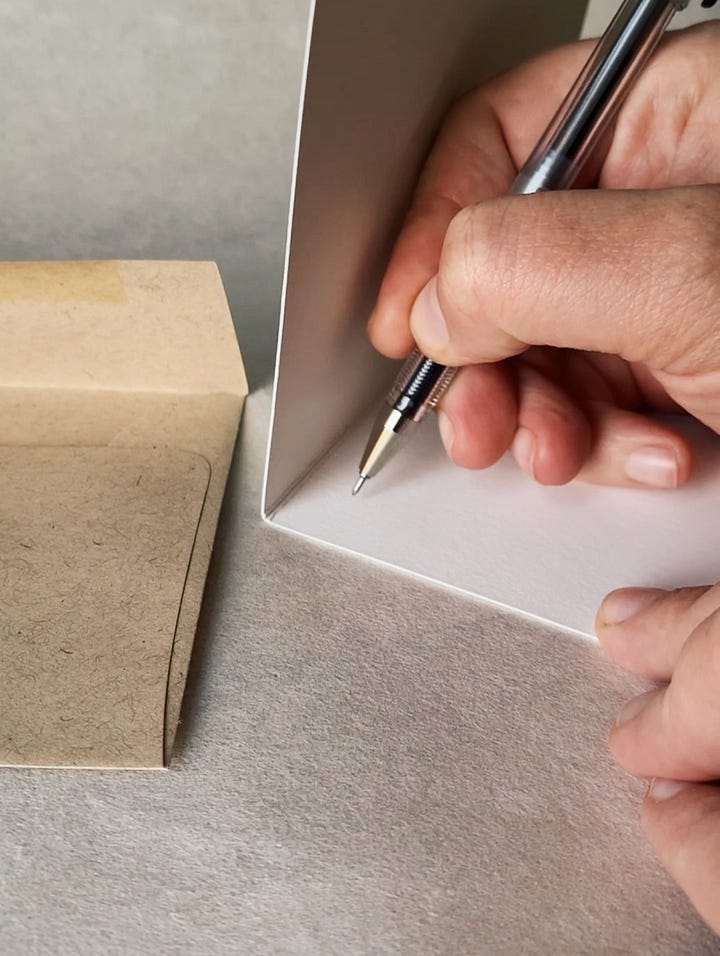
From the Studio:
Nourished by, Nourishing:
Repetitions of the archives over at Reverberation Radio. Reading One Continuous Mistake: Four Nobles Truths for Writers by Gail Sher. Watching this episode of Fashion Neurosis with Zadie Smith, on beauty and intellect, and the ways artists are in grounded conversation. Baking marbled mahleb black sesame shortbread.
Books purchased through the links above are part of an affiliate program. You support small bookstores, add to your libraries, and I receive a portion of commissions in the process. Thank you for your continued support of this work!
She goes on: “Chogyam Trungpa Rinpoche, a Tibetan Buddhist master, who says ‘We must continue to open in the face of tremendous opposition. No one is encouraging us to open and still we must peel away the layers of the heart.’ It is the same with this way of practice writing: We must continue to open and trust in our own voice and process. Ultimately, if the process is good, the end will be good. You will get good writing.”
I’m imagining Bruce Nauman here: “Press very hard and concentrate,” from the performance Body Pressure (1974)



